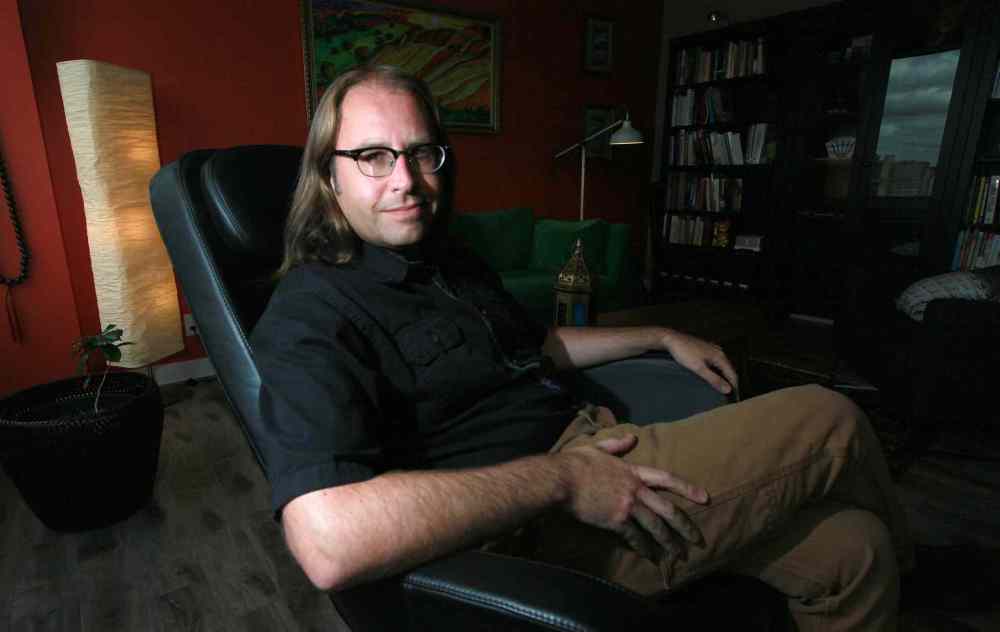Vicious online shamers always ready to pounce
But can Internet herd mentality bring about change?
Advertisement
Read this article for free:
or
Already have an account? Log in here »
To continue reading, please subscribe:
Monthly Digital Subscription
$1 per week for 24 weeks*
- Enjoy unlimited reading on winnipegfreepress.com
- Read the E-Edition, our digital replica newspaper
- Access News Break, our award-winning app
- Play interactive puzzles
*Billed as $4.00 plus GST every four weeks. After 24 weeks, price increases to the regular rate of $19.00 plus GST every four weeks. Offer available to new and qualified returning subscribers only. Cancel any time.
Monthly Digital Subscription
$4.75/week*
- Enjoy unlimited reading on winnipegfreepress.com
- Read the E-Edition, our digital replica newspaper
- Access News Break, our award-winning app
- Play interactive puzzles
*Billed as $19 plus GST every four weeks. Cancel any time.
To continue reading, please subscribe:
Add Free Press access to your Brandon Sun subscription for only an additional
$1 for the first 4 weeks*
*Your next subscription payment will increase by $1.00 and you will be charged $16.99 plus GST for four weeks. After four weeks, your payment will increase to $23.99 plus GST every four weeks.
Read unlimited articles for free today:
or
Already have an account? Log in here »
Hey there, time traveller!
This article was published 06/08/2015 (3722 days ago), so information in it may no longer be current.
Calling herself “Patient Zero” of cyber-bullying, Monica Lewinsky, the former White House intern whose relationship with then-president Bill Clinton became an unprecedented scandal in the late ’90s, stepped into the spotlight again last March with her landmark TED Talk in Vancouver called ‘The Price of Shame’. She garnered international attention in detailing how her experience — “losing a personal reputation on a global scale almost instantaneously” — has become frighteningly common online.

Also in March, Welsh journalist and author Jon Ronson released his New York Times bestseller So You’ve Been Publicly Shamed. Ronson spent three years interviewing the subjects of high-profile online shamings of a different sort, including Justine Sacco, the PR executive who lost her job after a racist joke she made on Twitter — “Going to Africa. Hope I don’t get AIDS. Just kidding. I’m white!” — went viral. And Jonah Lehrer, the journalist who was exposed for fabricating Bob Dylan quotes in his bestselling book, Imagine: How Creativity Works. And Lindsey Stone, the Massachusetts woman who posted a disrespectful photo at the Arlington National Cemetery. She, too, lost her job.
There are many more shamings like Sacco’s or Stone’s — some very close to home. In 2014, Lorrie Steeves, wife of former city councillor and Winnipeg mayoral candidate Gord Steeves, found herself under fire for a racist Facebook rant she made in 2010. Then there’s Brad Badiuk, the Kelvin High School teacher who was put on leave earlier this year after a series of controversial Facebook posts about aboriginal people.
Between the books, the TED talks and the litany of think pieces, it seems 2015 is the year of shame. Our collective anxiety around Internet shaming — and what justice can look like on the Internet — isn’t unfounded. After all, there’s no universally agreed-upon set of transgressions, and shaming comes in many forms. When we hear stories about people being taken down — or even when we participate in the taking down — many of us have had the same thought: this could happen to me.
 A Facebook post by Lorrie Steeves in 2010 surfaced last year during husband Gord Steeves’ campaign to be Winnipeg’s mayor. The post triggered a wave of online shaming. (Ken Gigliotti / Winnipeg Free Press files)
A Facebook post by Lorrie Steeves in 2010 surfaced last year during husband Gord Steeves’ campaign to be Winnipeg’s mayor. The post triggered a wave of online shaming. (Ken Gigliotti / Winnipeg Free Press files)
There’s been a lot of ink and airtime given to people who write terrible things online that come back to haunt them. But shame can also be a powerful tool. It’s when shame and social media come together that the lines start to blur. It’s troubling to think every transgression we’ve committed online is archived and retrievable, ready to be exposed to a potentially life-altering end. At the same time, social media have allowed us to hear perspectives from marginalized voices that have, for too long, been boxed out of traditional media — perspectives that, when widely shared, can change the behaviour of those who afflict them.
Can shaming, if used properly, effect real social change?
Mob justice part of legal system
Jennifer Jacquet would say yes, shaming can affect real change. In February, the assistant professor in the department of environmental studies at New York University released the book Is Shame Necessary? New Uses for an Old Tool.

Indeed, public shaming isn’t just an old tool — it’s an ancient one, used as part of the legal system in cultures all over the world for centuries. Many old-school forms of punishment — ‘mob justice,’ ‘pillory,’ ‘stocks,’ ‘tar and feather’ — are now used to refer to online shaming.
But Jacquet is less interested in shaming at the individual level. She’s more concerned with large-scale social dilemmas related to the environment, such as overfishing and climate change. In her book, she examines public shaming as “a non-violent form of resistance that can challenge corporations and even governments to change policies and behaviours that are detrimental to the environment.” In other words, place the focus on large groups, not individuals — unless those individuals have a significant impact on society.
To that end, she focuses not on the personal feeling of shame, but the public act of shaming, which requires an audience. “Given that the Internet is the easiest platform for shaming with the largest possible audience — a potential crowd of 2.7 billion (and growing) — it’s useful to consider what shaming online does for all of us,” she writes in a chapter titled The Scarlet Internet. Shame, she points out, has never been so cheap or so accessible.
And, in some cases, an individual will do something that affects the larger group.
When I connect with Jacquet, we are engrossed in the killing of Cecil the lion and the attendant outrage online. The beloved lion was a fixture of the Hwange National Park in Zimbabwe and was killed by Dr. Walter Palmer, a dentist and recreational big-game hunter from Minnesota.
Jacquet struggles with this example and whether the shame Palmer is facing is going to accomplish anything in the long term.
“There are aspects (of this case) that really challenge my general heuristic which is, let’s not go after individuals for things that don’t directly concern the group. This is a clear case of going after an individual for something that is really moral, and it affects the group, but in this very indirect way. It’s not like air pollution or water pollution where it’s a direct harm.”

Many people have mobilized and are pushing to ban imports of big-game trophies to the United States and European Union; Air Canada, Delta, United and American Airlines have all announced they would no longer transport them. Others are investing their energy into sending Palmer death threats.
But what does the latter really accomplish?
“We all have access to shame — to using it and becoming its victim,” Jacquet says. “We all really do need to think about, where do I lend my scornful gaze? What do I decide is worth my scrutiny? The more we think like that, the more we’ll find that it might be better to not emphasize bad behaviour, but ways in which to change the system or the law, so that behaviour is less common in the future.
“I don’t have much faith this guy’s practice will survive — in Minnesota at least,” she continues. “I don’t have much faith that he’ll be able to have a public reputation, at least with his real name. But is that the goal? I mean, again, where could this attention be used or funnelled to make changes that not only affect Palmer, but trophy hunters in the future?”
Shaming of Dr. Walter Palmer: “Because shooting #CecilTheLion in the park would have been illegal, he needs to be extradited, charged, &, preferably, hanged.”– @PETA, July 2015
With no context, there’s no empathy
Shaming of Dr. Walter Palmer: “Because shooting #CecilTheLion in the park would have been illegal, he needs to be extradited, charged, &, preferably, hanged.”– @PETA, July 2015
Shame is an emotion — a personal and powerful one. To understand shame as it is felt by an individual, it’s important to distinguish between shame and guilt. Brené Brown, an American shame researcher and bestselling author, puts it this way: “Shame is a focus on self, guilt is a focus on behaviour. Shame is, ‘I am bad.’ Guilt is, ‘I did something bad.’ ”
Behaviours can be changed, and they are shaped by many factors, including social norms, which also change. That’s why it’s generally more productive in the long term to label, challenge or call out a behaviour rather than labelling, challenging or calling out a person.
Brown has said empathy is the antidote to shame. Dr. Matthew Bailly, a Winnipeg psychologist, says empathy often disappears in shaming situations.
“It is very difficult to maintain empathy for another person when you have no context whatsoever in terms of the shaming and… whatever is being shamed,” Bailly says.
“And you also have no physical locality or anything like that to provide what typically gives us an idea that yes, the person on the other side of the table is a human being.”
With that in mind, using shame to change bad behaviour at an individual level might not have the desired outcome. When I ask Bailly if he thought shaming someone might encourage them to think before they post something potentially harmful on social media, he said no. “Most of us already think before we type. For those of us who don’t, shaming will typically only feed into the behaviour. What shame does, it erodes a person’s sense of self-worth. And typically what goes along with that is an increase in anger and frustration and an increase in disconnectedness with others, which will lead to more of the behaviour that was being shamed in the first place.”
Online, we can easily and quickly shine a spotlight on bad behaviour. Just look at the proliferation of Tumblr blogs: Public Shaming, which shames tone-deaf and often classist tweets; Hello there, Racists, which has since been taken down due to threats being made toward its subjects; Congrats, You Have an All-Male Panel!, which shames all-male panels; and Men Taking Up Too Much Space on the Train, which shames manspreading.
These blogs can be useful at challenging the status quo; perhaps people will take it a step further and change their behaviour. But, as Bailly points out, some people might double down.
“Drawing attention to a social issue is beneficial — but that’s different than shaming,” Bailly says. “Shaming gets more down to the worth of the human being.”

Public shaming might be a problem on the Internet, but it’s also a direct way to counteract the harassment that is rampant online, especially for women. It’s often the case harassment and shaming coexist.
Lyndsay Kirkham is a writer and professor at Toronto’s Humber College. She’s also a vocal feminist commentator on Twitter and experiences constant harassment.
Sometimes, she says, it’s important to engage with her harassers. For her, it’s about shining a light into the dark corners of the Internet.
“When people are watching me engage publicly with trolls, they only see like one-20th of the people who are constantly attacking me with Twitter and pictorial-based responses,” she says. “They only see a small percentage of the people I choose to engage with. If we don’t respond to that harassment at least on some level — and I know not everyone can do it, because we all have our own traumas and reasons for being silent in any situation. But when we have the capability of doing that, by engaging those people who are hiding behind the anonymity of a fake avatar or just the Internet in general, we expose the truth to people who are on the fence and don’t think these things exist.”
Online shaming also serves to amplify issues that have existed under the radar, says Saadia Muzaffar, founder of TechGirls Canada, a hub for Canadian women in science, technology, engineering and math, and a prolific tweeter on all issues related to social justice.
“It’s only now that we have the chance for marginalized voices to have almost the same kind of platform and access as other voices have had historically,” she says. “Historically, the power to shame has rested with very few people: your religious leaders, the men in your society, whatever. I think what bugs people now is the kinds of people who are able to shame. So much of religion is built on shaming, yet we don’t hear so many complaints. But we hear about women calling others out, or people of colour calling white people out. We need to take a step back and dissect why shaming in 2015 is as big a problem as we are led to believe by traditional media.”
Muzaffar makes an important point; look at the highest-profile victims of online shaming, and you’ll see mostly white faces who have been shamed for saying something racist or sexist.
Social media, however, provide an incredible opportunity for us to learn from each other — and each other’s mistakes — so long as we’re receptive. “Some celebrity being shamed for something will probably affect the celebrity far less than the opportunity for other people to use that as a window to have some personal introspection,” Muzzafar says.
At the other end of the spectrum, public shaming can be employed as a bullying tactic — particularly if the intent is to humiliate. In 1998, when Lewinsky found herself at the centre of “a political, legal and media maelstrom like we had never seen before” (her words), she was called a tramp, tart, slut, whore and bimbo by, as Bailly points out, seemingly legitimate sources — from late-night comedy to mainstream news media. She was a victim of bullying. Rehtaeh Parsons, the Halifax teen who took her own life after photos of her being sexually assaulted were spread around the Internet, was also a victim of bullying. These are but two different examples of an increasingly common brand of humiliation. In fact, it’s so common we now have a name for it: slut-shaming.
When does shaming become bullying? Jacquet says it all has to do with power.
“Bullying implies a power dynamic in which the powerful are picking on the less powerful,” she says. “The little boy claiming the emperor has no clothes could be defined as shaming, but it wouldn’t be called bullying.”
 Protestors leave signs and stuffed animals in front of the dental practice of Dr. Walter Palmer, who is accused of killing Cecil, a beloved lion in Zimbabwe. (Glen Stubbe / TNS files)
Protestors leave signs and stuffed animals in front of the dental practice of Dr. Walter Palmer, who is accused of killing Cecil, a beloved lion in Zimbabwe. (Glen Stubbe / TNS files)
Shame is a powerful weapon
As Jacquet reiterates in her book, shame is a tool best used sparingly and with precision. But it is necessary.
“It’s so impossible to argue the other way,” she says. “It’s such a deep part of human evolution and human society — but, again, it matters how you define it. There could be very good reasons to try to eliminate from our daily lives the kind of shame that Brené Brown talks about at TED or Jonathan Franzen talked about — that deep personal feeling of shame. But in terms of a tool, one of these levers we have, it is integral in keeping society functioning for the benefit of the group.”
Still, she says, 2015 is the time to think deeply about shame and how we wield this powerful tool. “There’s a need to tease apart the mechanics of shame. It’s not just, ‘shame is bad’ — that sort of knee-jerk instinct. There are issues of disproportionality, or lack of trial by jury, the lack of the democratic justice system that might actually be more concerning in any particular case than shame, per se.”
And that’s where empathy comes in — especially when we’re talking about shaming on an individual level. In her TEDTalk, Lewinsky pleaded for a more compassionate world. “We need to communicate online with compassion, consume news with compassion and click with compassion. Just imagine walking a mile in someone else’s headline.”
That thought many of us have had — this could happen to me — might inspire us ask ourselves important questions: does this person deserve to be shamed? Is the punishment proportional to the crime? Is this where I want to focus my attention?
As an antidote to shame, empathy may be the real key to affecting social change. Once the shaming is done, and the behaviour is scrutinized, how can the process make a difference? By remembering we are all humans, suggests Bailly.
“When it’s identified, we actually need to make conscious efforts to empathize and connect with the person who has been shamed,” he says. “We should actually do just the opposite of what’s happening. This can sound very difficult, especially if you’re dealing with racists, sexists, misogynists, violent offenders, predators. But I haven’t seen much of a solution in past attempts to marginalize, demonize and erode the humanness of even some of the people I would have difficulty sitting in the same room with.
“We should be developing empathy — and actually encouraging empathy and connection — rather than stitching scarlet letter As onto them.”


Jen Zoratti is a columnist and feature writer working in the Arts & Life department, as well as the author of the weekly newsletter NEXT. A National Newspaper Award finalist for arts and entertainment writing, Jen is a graduate of the Creative Communications program at RRC Polytech and was a music writer before joining the Free Press in 2013. Read more about Jen.
Every piece of reporting Jen produces is reviewed by an editing team before it is posted online or published in print – part of the Free Press‘s tradition, since 1872, of producing reliable independent journalism. Read more about Free Press’s history and mandate, and learn how our newsroom operates.
Our newsroom depends on a growing audience of readers to power our journalism. If you are not a paid reader, please consider becoming a subscriber.
Our newsroom depends on its audience of readers to power our journalism. Thank you for your support.
History
Updated on Saturday, August 8, 2015 12:26 PM CDT: Fixes typo.

